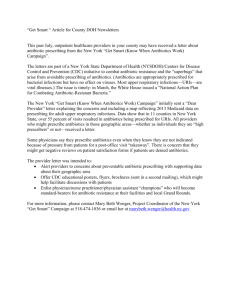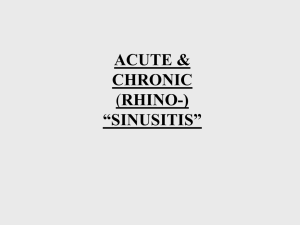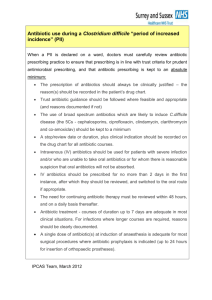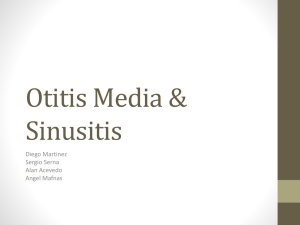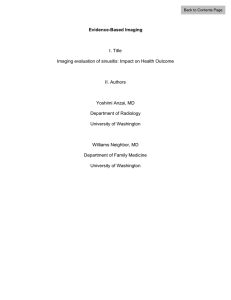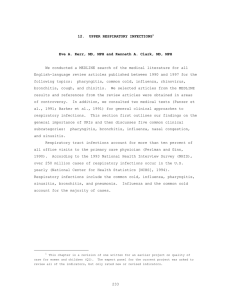sinusitis - Bradford VTS
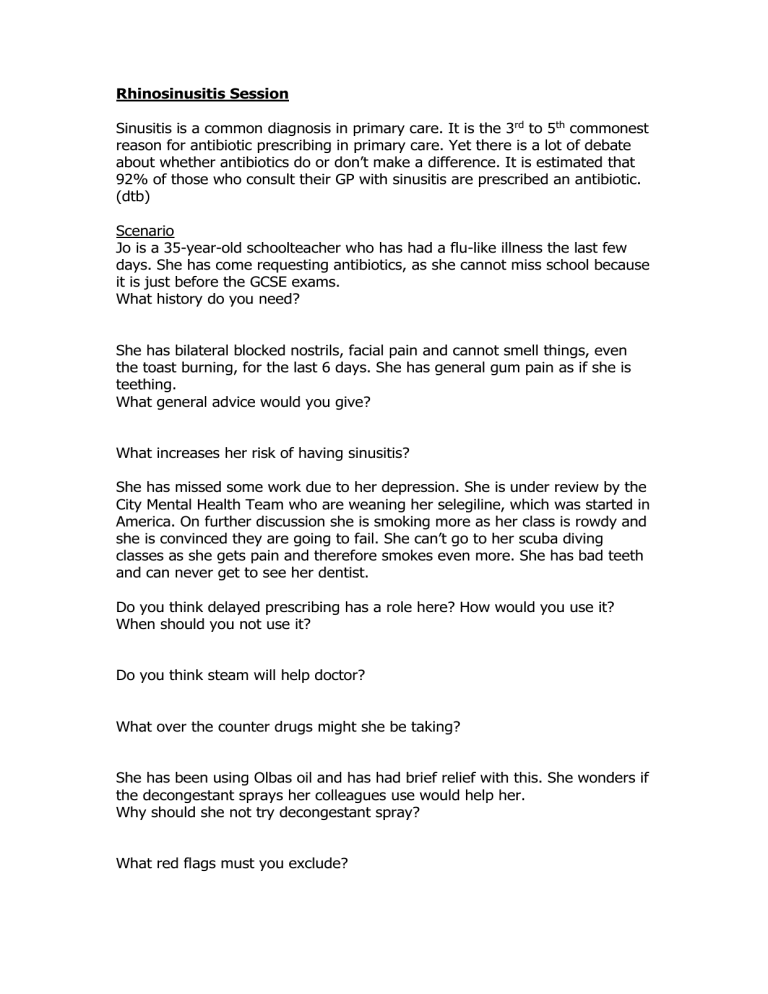
Rhinosinusitis Session
Sinusitis is a common diagnosis in primary care. It is the 3 rd to 5 th commonest reason for antibiotic prescribing in primary care. Yet there is a lot of debate about whether antibiotics do or don’t make a difference. It is estimated that
92% of those who consult their GP with sinusitis are prescribed an antibiotic.
(dtb)
Scenario
Jo is a 35-year-old schoolteacher who has had a flu-like illness the last few days. She has come requesting antibiotics, as she cannot miss school because it is just before the GCSE exams.
What history do you need?
She has bilateral blocked nostrils, facial pain and cannot smell things, even the toast burning, for the last 6 days. She has general gum pain as if she is teething.
What general advice would you give?
What increases her risk of having sinusitis?
She has missed some work due to her depression. She is under review by the
City Mental Health Team who are weaning her selegiline, which was started in
America. On further discussion she is smoking more as her class is rowdy and she is convinced they are going to fail. She can’t go to her scuba diving classes as she gets pain and therefore smokes even more. She has bad teeth and can never get to see her dentist.
Do you think delayed prescribing has a role here? How would you use it?
When should you not use it?
Do you think steam will help doctor?
What over the counter drugs might she be taking?
She has been using Olbas oil and has had brief relief with this. She wonders if the decongestant sprays her colleagues use would help her.
Why should she not try decongestant spray?
What red flags must you exclude?
Acute Rhinosinusitis
Defined as inflammation of the nose and paranasal sinuses for 12 weeks or less with 2 or more of the following symptoms:
Blockage/ congestion
Discharge (anterior or posterior nasal drip)
Facial pain or pressure
Reduced or loss of smell
Commonly occurs a week or so after an URTI
Bacterial sinusitis developed in 2% of patients with viral sinusitis. Usually caused by Streptococcus pneumoniae or Haemophilus influenzae.
Predisposing factors for acute sinusitis include allergic rhinitis, allergy/asthma, smoking, diabetes mellitus, dental infections and mechanical abnormalities such as deviated nasal septum. Rare problems you shouldn’t forget that predispose include CF, PCD (increasing in Asian population in Bradford), immunodeficiency, Neoplasia, Sarcoidosis, Wegner’s granulomatosis and the use of nasogastric tubes.
Really quirky: Samter’s triad- aspirin sensitivity, rhinitis and asthma.
If it lasts more than 12 weeks it is defined as chronic sinusitis, irreversible damage to the sinus epithelium and polyp formation may have occurred.
Then refer to ENT for nasendoscopy, CT, MRI/ FESS.
Subdivisions
Acute: infection lasting 7-30days
Subacute: inflammation lasts 4-12 weeks
Recurring: 3 significant acute episodes/ year lasting more than 10days with no interim symptoms
Chronic: symptoms for more than 90 days, may be caused by irreversible changes in the mucosal lining =/- acute exacerbations
Differential Diagnosis
Allergic rhinitis
Nasal foreign body
Adenoiditis/ tonsillitis
Sino-nasal tumour
Management
Paracetamol and Ibuprofen and reassure with advice that within 2-3weeks it should resolve.
Mostly it has a viral cause and therefore unlikely to be helped by antibiotics.
After 2 weeks may be helpful to give steroids/ antibiotics.
To cover the 2% that develop bacterial infection should give antibiotics if:
Symptoms more than 7 days
Deterioration
Pre-existing co-morbidity eg. Heart, lung, renal, CF etc.
Delayed prescription i.e. Symptoms do not resolve and have marked pain, purulent discharge etc.
Antibiotics
Cochrane
8 out of 10 patients will improve within 2 weeks vs 9 out of 10 with antibiotics. 57 studies reviewed and found that cure rate is high in both placebo group 80% and treatment group 90%. But in groups where they did not achieve clinical cure the antibiotic group were better than placebo.
Doesn’t matter which antibiotic you use penicillins, macrolides, tetracyclines, cephalosporins or Co-amoxiclav.
NICE
Advise a no antibiotic prescribing strategy or a delayed antibiotic prescribing strategy should be agreed for patients with acute sinusitis, unless systemically unwell then give antibiotics and perhaps refer on to secondary care.
NHS Guidelines
Give antibiotics if symptoms have persisted for more than 7 days or if symptoms are severe or deteriorating significantly.
Steroids
Intra-nasal corticosteroids
Cochrane
4 studies with 1943 patients found patients receiving intra-nasal corticosteroids were more likely to have resolution/ improvement than placebo (73% vs 66.4%). Higher dose of intra-nasal steroid had a stronger effect eg. Mometasone 400mcg vs Mometasone 200mcg.
Used alone or with antibiotics.
Steam Inhalation and Nasal Irrigation
Steam inhalation has little evidence but is recommended in the BNF esp. for maxillary sinusitis.
Nasal irrigation with hypertonic saline 150ml per nostril for 6 months showed improvement in QOL scores, fewer sinus headaches, less frontal pain, less frontal pressure and less nasal congestion. They were also less likely to be prescribed antibacterial therapy.
Nasal Decongestant
Currently under review at Cochrane
Thought to promote muco-ciliary clearance and sinus drainage.
Very few RCTs assessing these but commonly used over the counter drugs.
RCTs show conflicting results.
Rebound congestion on withdrawal therefore only recommended to be used for 7 days or less.
Ephedrine nasal drops are safest according to the BNF.
Beware all sympathomimetics can cause hypertensive crisis if used during treatment with Monoamine oxidase inhibitors.
Refer
If serious complication eg. Periorbital infection
If suspected sinonasal tumour
Unremitting or progressive facial pain
When second-line antibiotic treatment has failed
If chronicie more than 12 weeks
If any red flags present
Sino-nasal tumour
Suggested by persistent unilateral symptoms such as blood stained discharge, crusting or facial swelling.
Red Flags
Unilateral signs (unilateral polyp or mass)
Bleeding
Diplopia or Proptosis
Maxillary paraesthesia
Orbital swelling or erythema
Suspicion of intracranial or intraorbital complication
Immunocompromised patient
Resources used and References
Drugs and therapeutic Bulletin Vol47/ No3/ March 2009 www.dtb.bmj.com
Cochrane
NICE clinical guideline 69 Respiratory tract Infections-antibiotic prescribing www.nice.org.uk/Guidance/CG69
InnovAiT Vol2/ No1/p56-58 Jan 2009 www.patient.co.uk




